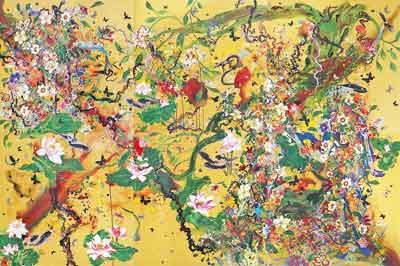Unravelling Priyantha’s pretty world of flora and fauna

Priyantha’s current exhibition invites political, cultural and humanitarian dialogue
Priyantha Udagedara’s works are paradisiacal dreamscapes filled with lush adornments of tropical flora, leaping mythic fauna, and brick ruins overcome with vines. The canvas seems to explode. It is a resplendent treat for the eyes. When initially taken in, the paintings come as quite a surprise. An admittedly unusual feeling in contemporary art; of seeing a simple, familiar, easy-on-the-eyes kind of beauty. It is a breath of fresh air. Accessible, but in a contemporary context? Hoorah! These works are the comfort food of contemporary painting.
Yet, it tempts sustained looking and naturally I am compelled to move forward to study the painting closely. With every step, the works lose their sense of comfort. I take one step: The harmonious whole, begins to reveal deviances. Step two: What I thought were carefully rounded edges now reveal jagged points. Step three: Splashes of paint where they should not be. Step four: This is not a painting in its entirety, there are printed cutouts embedded into the canvas. Step six: Little humanoid, limb-snapping, blue creatures crawl and scuttle around thorny thickets. Step seven: The fauna grow furry tails and sharp teeth, birds become vermin and the body of a dotted creature snakes through the flowers dripping liquid on their petals. Step nine: This is dirty. Step ten: Yet here I am, enjoying it.
Priyantha Udagedara’s exhibition “Orientalism” involves the viewer in a type of performative exchange “to unearth -and concurrently interpret- what is beneath the deception of the exoticism in brazen display.” To fully realize the significance of this body of work however requires us to look back at Priyantha’s last two exhibitions: Paradise Lost (2012) and Herbal Gardens ( 2015). The former handled themes of the violence stemming from the civil conflict and the latter a somewhat investigative look into the underground sex trade in Sri Lanka. Both used the same technology of playing with distance and close-ness in observation to expose something to the viewer. Both used floral veneers to entice, and both revealed an insidious underbelly lurking behind.
This technology is repeated in Orientalism, yet it would be remiss to suggest that the art and the artist have simply stuck to a formula that works and have ceased to evolve. Rather, while stylistically the differences may seem miniscule, the conceptual leap made from the last two bodies of work is nothing short of tremendous.
Priyantha has managed to pivot conceptually while exercising restraint and respect to his personal commitment to the form. Before, the viewer was brought in only to be revealed a dark and painful reality, prompting either an instinctual avoidance or a type of political awareness. In the case of Orientalism however, the viewer, tempted by the promise of tropical exoticism is brought in only to be revealed a darker more attractive form of barbaric exoticism. This fuels the cannon of stories about tropical danger, adventure and discovery in colonial empires.
Priyantha Udagedara, based a lot of his research for this body of work on Edward Said’s seminal book Orientalism. Coincidentally when seeing Priyantha’s work I was reminded of Stuart Hall’s book, The West and the Rest: Discourses on Power which used Edward Said’s book as a foundation. In his chapter titled Idealization Hall identifies five key themes for orientalism to take root and for fantasy to be constructed. The first; the unfortunate privilege of being seen as the “The Golden World; an Earthly Paradise.” Hall’s second point, suggests, that the land and its people are seen as “the simple” living an “innocent life.” Hall’s third and fourth point, suggest that the land is seen as having a “lack of developed social organization and civil society” and that “people live in a pure set of nature”. Finally the focus falls on sexuality, its loose reigns and nakedness.
The experience of viewing Priyantha’s paintings seems to mirror the progression of Stuart Hall’s analysis. The viewer is filled with joy as they see the piece at a distance, much like the colonial projection of a tropical paradise in the distance. It could also serve as a measurement for the present where the colonized themselves evoke a type of reductive paradisiacal essentialism? A kind of cognitive imperialism. A left-over habit of selective representation that simplifies and ignores the inconvenient side of Sri Lanka. And then as the viewer steps closer to look at the works, the blue crawling blue figures, and the animal deviances offer an enticing mystical barbarism that begs to be ordered, civilized, sexualized, clothed and controlled.
Given the presence of unmistakably East Asian motifs and styles in the works however, is Priyantha possibly questioning the potential of a new double orientalism? One, unmistakably Sri Lankan and another growing much like the brick walls from the potential increase in East Asian immigration and trade deals to and with Sri Lanka.
We might not have the answers to these questions, but Priyantha has been successful in compelling us to ask them. While his previous works held a more overtly political message, in this body of work Priyantha takes on the role of mediator connecting symbols, behaviours, and motifs to prophetically generate critical conversation. These works are political, but exist outside of the usual political discourse. By doubling down as the mediator of symbols that evoke colonial, post-colonial, and new-trade exchanges, Priyantha’s works invite political, cultural and humanitarian dialogue.
To show such restraint in execution while making strides conceptually is notable and makes us privy to the seriousness with which Priyantha takes this task. From the various types of tropical leaves and flowers featured to the circling animals, every detail of the works is heavily researched and cataloged revealing quite a contemporary practice behind traditionally rendered works.
Orientalism by Priyantha Udagedara is open to the public from December 8 till January 6 at the Saskia Fernando Gallery, 41 Horton Place, Colombo7 open daily from 10 a.m. to 6 p.m.


